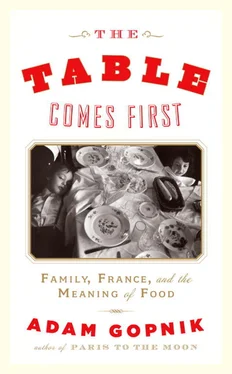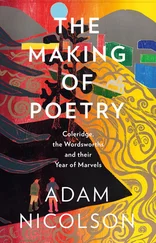In search of the truth about the new sweets, I even went to the White House, whose pastry chef, Bill Yosses, I had been made to understand, was the Great Still Center of the American dessert. Yosses turned out to be a smiling, vaguely seraphic presence—at one point, he neatly, calmly distinguished caramel, mere burnt sugar, from butterscotch, brown sugar mixed with butter, for the benefit of his sous-chefs.
“Dessert is aspirational,” Yosses said, laying out his philosophy. “It’s the one part of the meal you don’t have to eat. It’s the purest part of the meal: the art part. But it’s also the greediest part, the eat-it-in-a-closet part. We don’t have to have it, and we do. When I was a kid, I would stuff my face with éclairs. I still would, I guess…” His voice trailed off. “The real question is this,” he said. “How did this thing, this spice, sugar, become a staple? How did something that ought to be like saffron, a rare thing to add, become the thing we build on? How did a whole way of cooking creep up from sweetness? Why do we use it to end the meal? Those are the big questions.” I asked if I should go to Spain. He gave a Yoda-ish smile, and said, “Oh, yes. That’s a trip you ought to take.” When I consulted Dan Barber again, he was still more emphatic. “Go there!” he said. “That’s where it’s all happening. Go!” And so I went.
On the plane over, I felt like Alec Guinness or Michael Caine in a Cold War spy movie of the somber, le Carré or Len Deighton kind: a black-and-white film, with a jazz score and a grimly ambiguous ending. I was crossing the salt-caramel curtain, and no turning back.
When I got to Barcelona, there was, just as there ought to be in such a movie, a cool, efficient beauty, in a black frock and a sports car, waiting for me. This was Lisa Abend, an American writer who lives in Spain, and who was to be my companion in Barcelona. She had spent the past season observing the innards at elBulli, while writing a book about the Oompa-Loompas of the operation.
It was twilight, and we sped through the dark, narrow streets of the Old City on the way to our first stop, the Espai Sucre. This “Sweet Space” was, Lisa explained, a working research laboratory and school, where new desserts are regularly conceived and experiments made, with the results exhibited, and eaten, at a nearby restaurant. As we drove, the almost kinetic energy of the Catalan capital was evident, as it had been the last time I was there, twenty years before. At the time, the only dessert seemed to be flan, with a distinct salty taste that I associated with the local café con leche . I asked what had happened in the twenty years since.
“I’ve been doing a lot of research, and it really seems to be the case that the legend is the truth,” Lisa said. “Twenty years ago, the Adrià brothers took over a struggling French restaurant up in Roses, and in the nineties they began to collaborate with a chemist here at the university. And, being isolated and inexperienced, they began to do new things. It really did come from two intense brothers who didn’t care what the rules were supposed to be.”
We pulled up in the darkness to a modern glass storefront amid the medieval buildings and parked on the sidewalk. Inside, Jordi Butrón, the chief scientist-cook of the research center, greeted us solemnly and led us into his classroom. On the blackboard behind his head was a series of abstruse-looking diagrams. With a close-shaved beard and mustache, he had more the look of a severe French sociologist than of a happy Spanish cook. I explained that I was on a quest to find out what desserts really were and where they were going. He held up a hand and began to speak, in rapid, accented French.
“In retrospect, they’re disgusting, many of the things we used to do—too much fat and too much sugar, and a series of clichés taught while being rationalized,” he said. “The key thing now for a cook is to develop a library of flavors that you can recall. If I say to you, ‘Apple and cinnamon,’ you would click in immediately. ‘Yes, apple! Yes, cinnamon!’ The library of your mind contains that. But what if I say ‘Apple, asafetida’? Nothing! You have nothing stored there.” He added slyly, “Now, this is a benefit to the chef, because if I do apple and cinnamon and you don’t like it you think there’s something wrong with me, but if I do apple and asafetida and you don’t like it there’s something wrong with you.” He laughed briefly, professionally. “The development of a pastry chef is not the development of techniques. It is the slow, careful development of a catalogue of savors and flavors, which you can develop the way you develop muscles. There is a logic in every dessert worth eating. Consider the logic of white peach and rich cheese. We must be conditioned not by sight but only by flavor, the tongue, the nose, and the feel in the mouth.” He went on placidly, “It is to avoid these errors that we do so much of our teaching and learning blindfolded.”
“Blindfolded!” I said, wondering if I had misunderstood. We had been struggling with each other’s French.
“Yes, blindfolded,” he repeated. He went to a drawer and took out a handful of silken eye masks, which he threw on the desk. “It is important to be able to work with the sensations of the nose and mouth alone, so we spend hours in the dark, tasting. Of course, appearance matters, but it is the last part of the equation. Taste, taste, taste—that is what matters. So I keep people blindfolded for much of the work, which is devoted to the marriages of taste.”
Then he opened the door to an immense, pristine kitchen, dominated by a great length of polished black stone. Here, he said, “as many as fourteen young chefs can work, blindfolded, to discover the taste and enlarge their flavor libraries.”
I noticed various pieces of space-age-looking machinery littering the beautiful, dark kitchen, and I asked how the new technology contributed to his work.
“It is useful as tools,” he said crisply. “If I want to capture the flavor of a raspberry meringue, I use a powdered egg white, and then I have a true raspberry in the form of a meringue, instead of a super-sweet meringue overwhelming raspberries.” He shrugged. “Nothing we do with new equipment does more than allow us to reinsert flavors.”
We sat down for dinner in the nearby restaurant, and had a meal of five courses, all sweet, or at least sweetish, yet all beginning with a savory theme. First, there was cucumber-ginger-pineapple-tarragon sherbet, then olive-oil cake with San Simón cheese and a perfect white-peach sorbet. “The combination is a classic conception of the savory kitchen: cheese and olive oil,” Jordi observed. Then came a cake made with stout, beets, cherries, and Idiazábal cheese, too various to make much sense. Then a green-apple granita with bay leaf, as fresh and acid as a winter morning, and, finally, truffle-hazelnut-toast cream pudding. The genius showed in the details: a curry-and-salt cookie, thrown in as an extra but a study in itself. There was something perfectly modulated in the transition from savory herbs (tarragon and bay) and savory tastes (salt and curry, particularly) into sweet dishes.
“This is kind of amazing,” I said to Lisa, as I scraped the plate of truffle-toast pudding and grabbed another curry-and-salt biscuit. Lisa gave me a seraphic, you-ain’t-seen-nothing-yet smile, and said, “You’ll meet Albert tomorrow.”
I sat in my little hotel room in Barcelona, jet-lagged and sugar-satiated, and read about the history of sugar. Primates, I learned, love sweets for reasons that are simple enough to explain: sweetness is the natural sign of ripeness, and the best assurance, especially when balanced with just enough acids, that the thing you’re eating is good to eat.
Читать дальше












